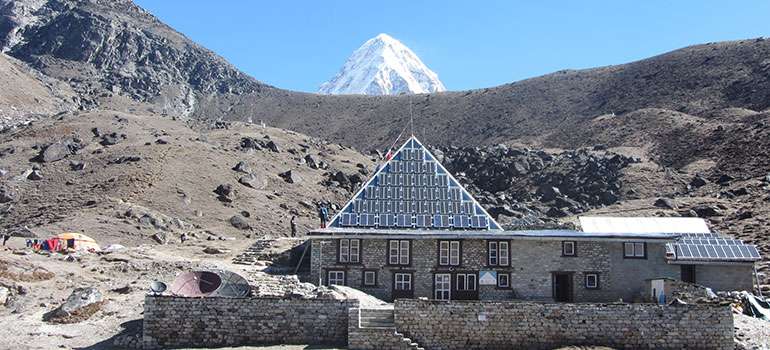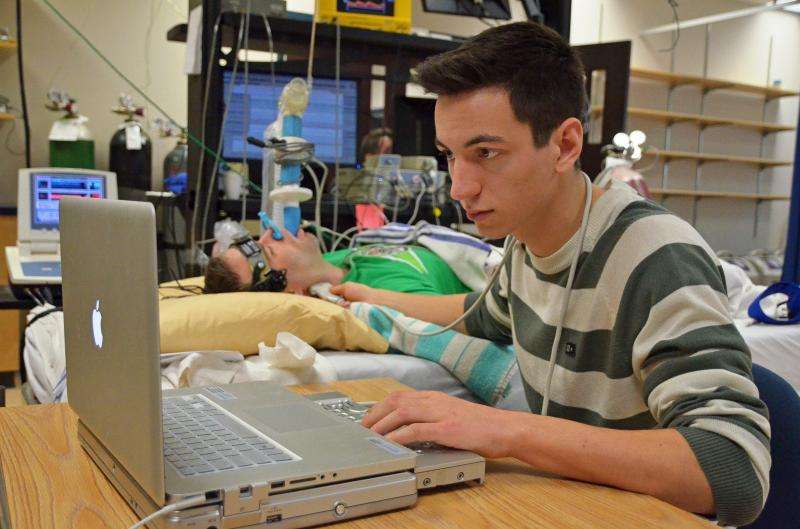Research at base of Mt. Everest shows impacts of high altitudes on cardiovascular health

As an undergraduate student in the School of Health and Exercise Sciences, Ryan Hoiland travelled on a scientific expedition to Nepal, working in the shadow of Mount Everest to study the effects of severe oxygen deprivation and blood flow to the brain.
Now, Holiand's work as a graduate master's student is offering new understandings of human physiology. The findings are based on research conducted at the international Pyramid Laboratory near the Everest Base Camp.
This research compares data from human testing at sea level with those conducted in the Himalayan high altitudes to measure pulmonary pressures, a predictor for developing pulmonary edema, a severe high-altitude illness. Measurements were done on human subjects suffering hypoxia from the low atmospheric oxygen levels, causing high pulmonary blood pressure.
Key differences emerged from the mountain testing, done over two weeks under actual high-altitude conditions, compared to previous testing at sea-level in normobaric pressure chambers, which manipulated body responses for only a few hours at a time.
"We found that there is no relationship between responses at sea level compared to high altitudes," said Hoiland. Differences in blood viscosity (thickness of blood) at high altitude were not replicated in the sea-level data.
"One of our conclusions is that there is a limited ability of sea-level tests to predict high-altitude outcomes."

The study results will be useful in predicting the health outcomes of patients suffering from a host of cardio-pulmonary problems.
Hoiland's second study is published in the Journal of Physiology, exploring the relationship between brain blood flow and breathing.
The research compared human data over the last 25 years, even linking to animal studies done in the 1950s. The earlier human studies measured blood flow response to brain regions not responsible for the control of breathing—a severe limitation.
Hoiland wanted to revisit the research and incorporate technological advances.
Using methods and equipment unavailable years ago, Hoiland re-tested the old hypotheses – but measured blood flow to the posterior portion of the brain – including flow to the brain stem, the area that controls breathing.
The findings? The posterior brain blood flow measures showed that during hypoxia – decreased oxygen flow to the brain, as occurs during a stroke – breathing increases, plateaus and then decreases, with the relative decrease in breathing related to the blood flow response.
"This has not been measured before," said Hoiland.
The key discovery is that blood-flow responses act to reduce the breathing changes and blood oxygen levels brought on by hypoxia.
Such research had never been conducted measuring posterior blood flow, as opposed to the historic, anterior brain studies. This research provides insight into the underlying pathology of disordered breathing, for example, as a result of sleep apnea.
More information: "Chemoreceptor responsiveness at sea level does not predict the pulmonary pressure response to high altitude." Chest. 2014 Dec 11. DOI: 10.1378/chest.14-1992
"Indomethacin-induced impairment of regional cerebrovascular reactivity: implications for respiratory control." J Physiol. 2015 Mar 1;593(5):1291-306. DOI: 10.1113/jphysiol.2014.284521
"Is nitric oxide mediated sympatholysis improved with exercise? Yes or No?" J Physiol. 2015 Mar 1;593(5):1045-6. DOI: 10.1113/jphysiol.2014.286815


















